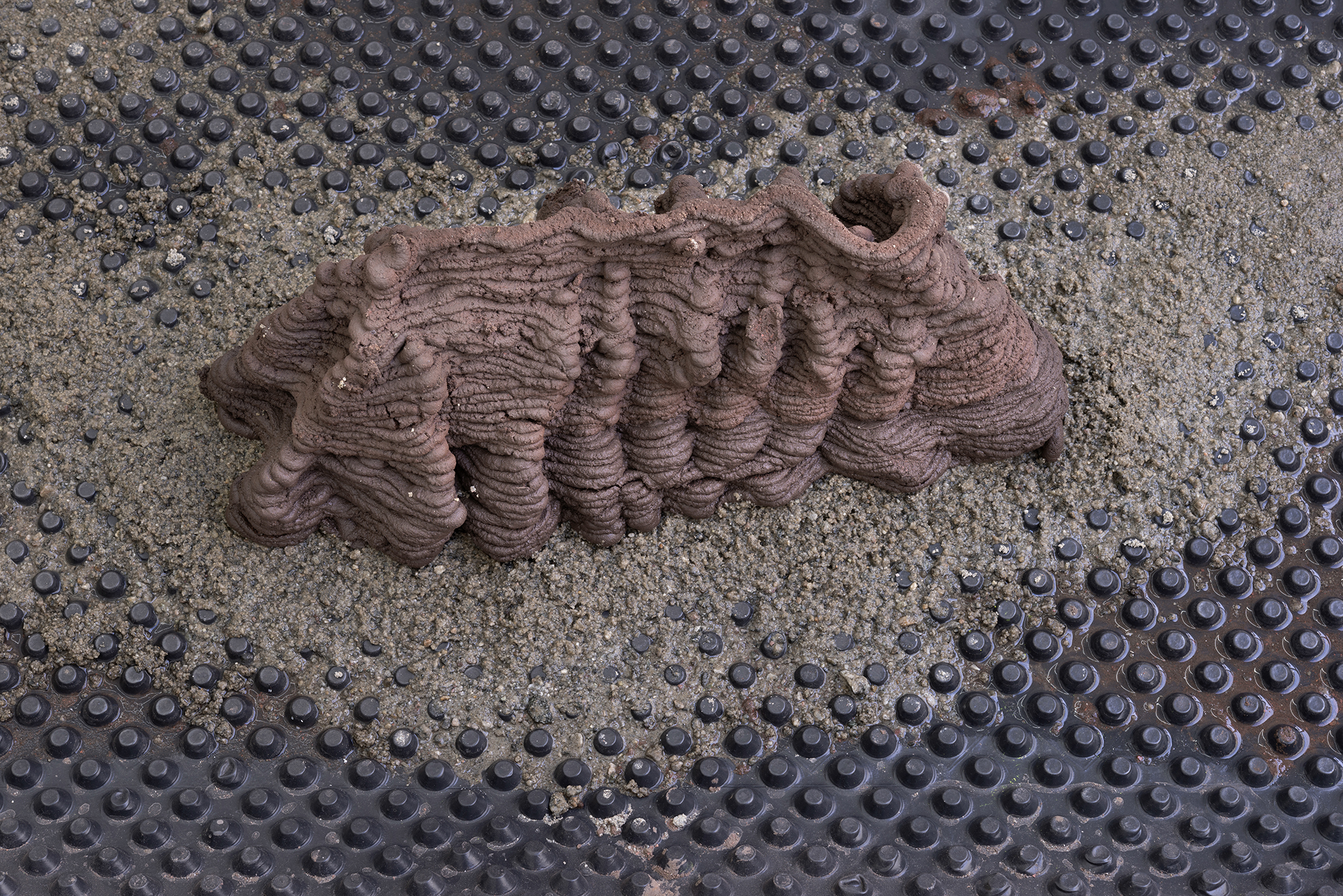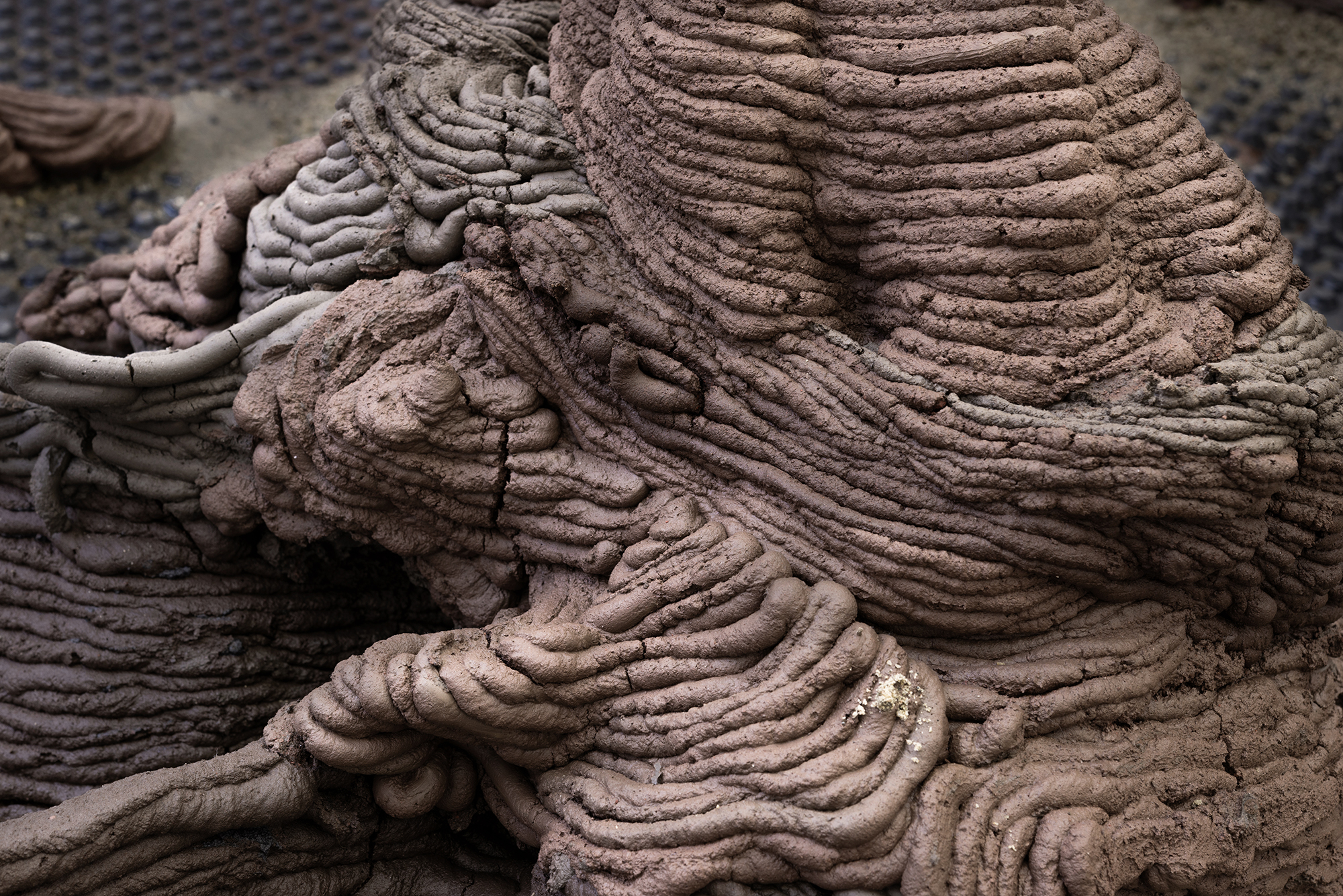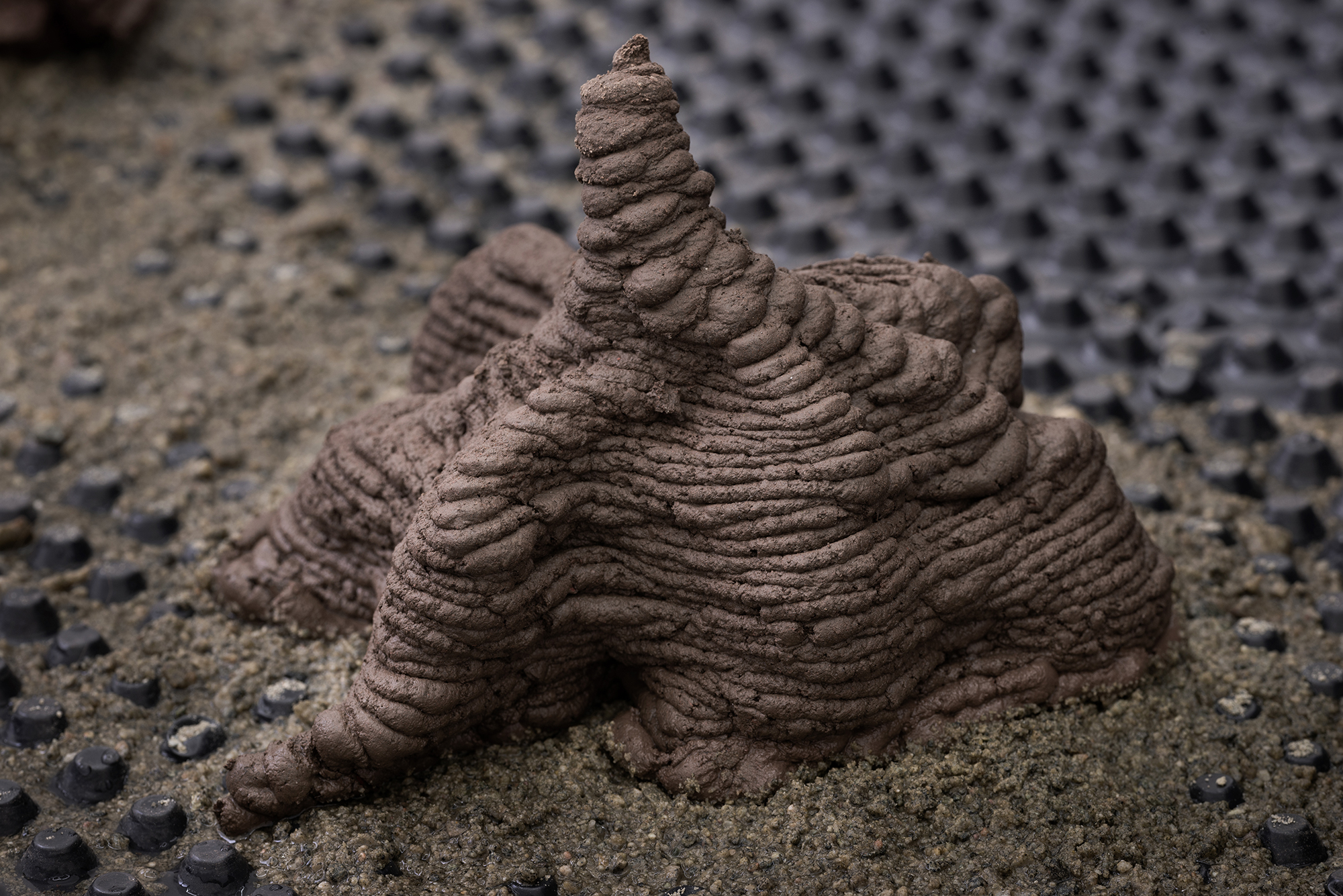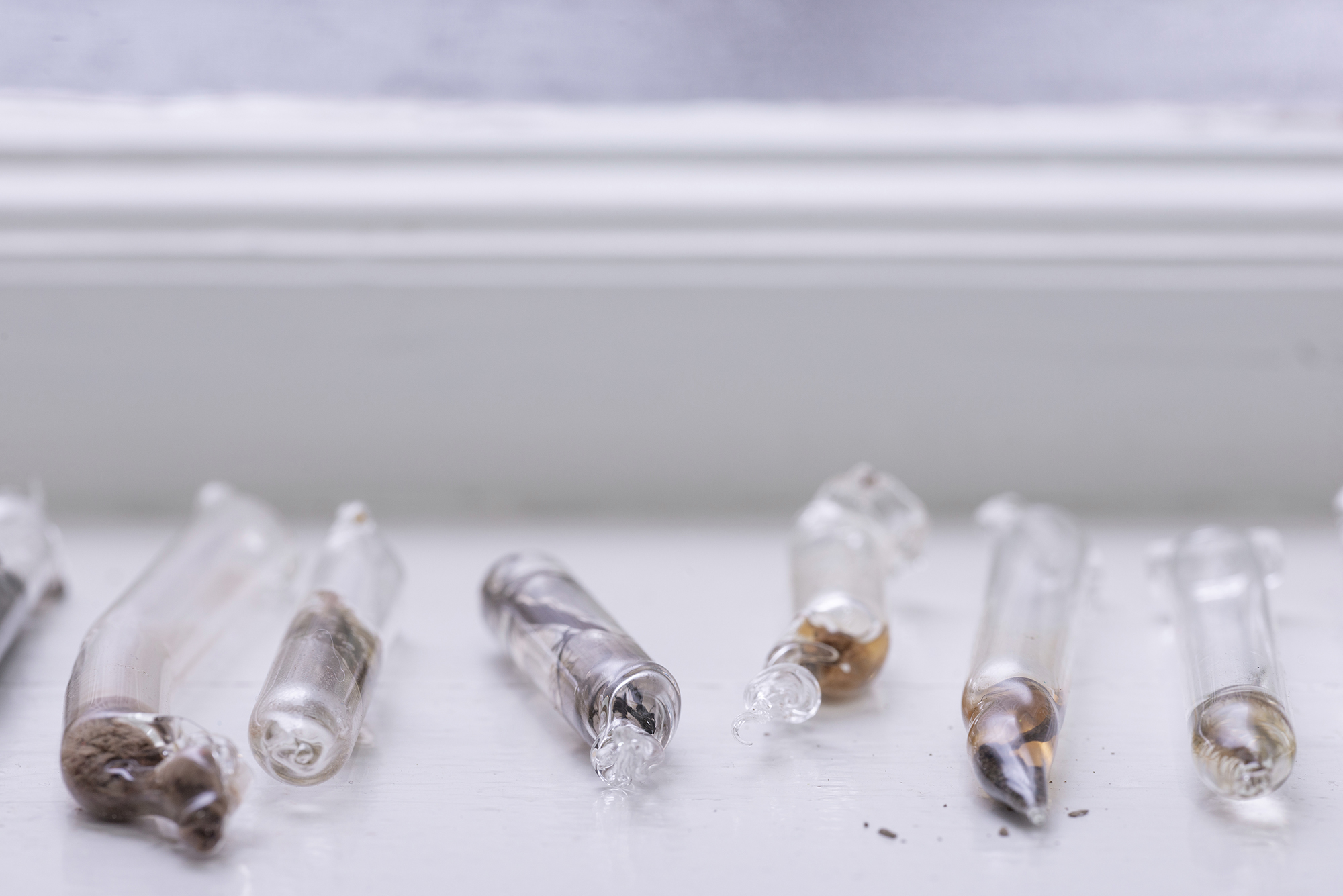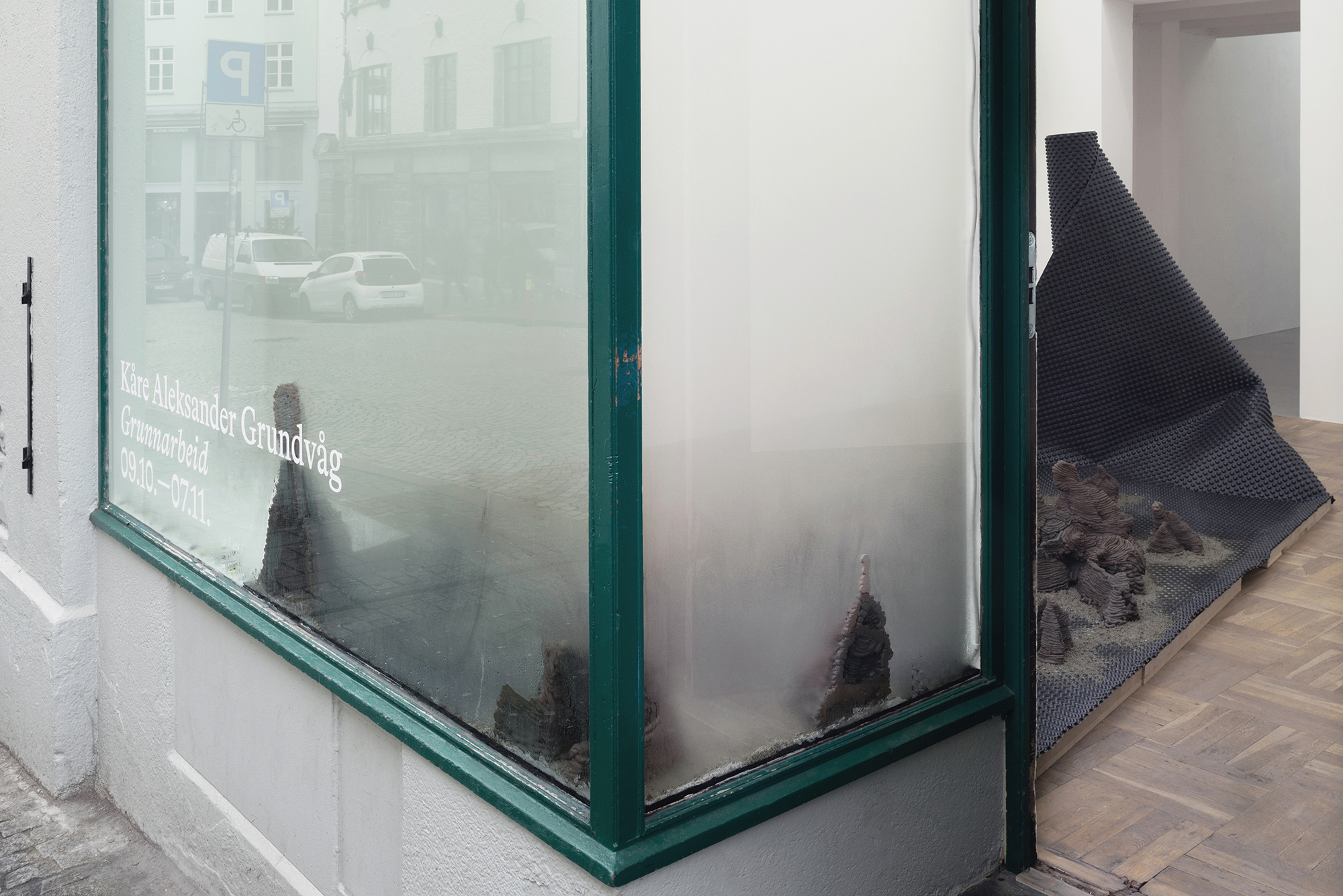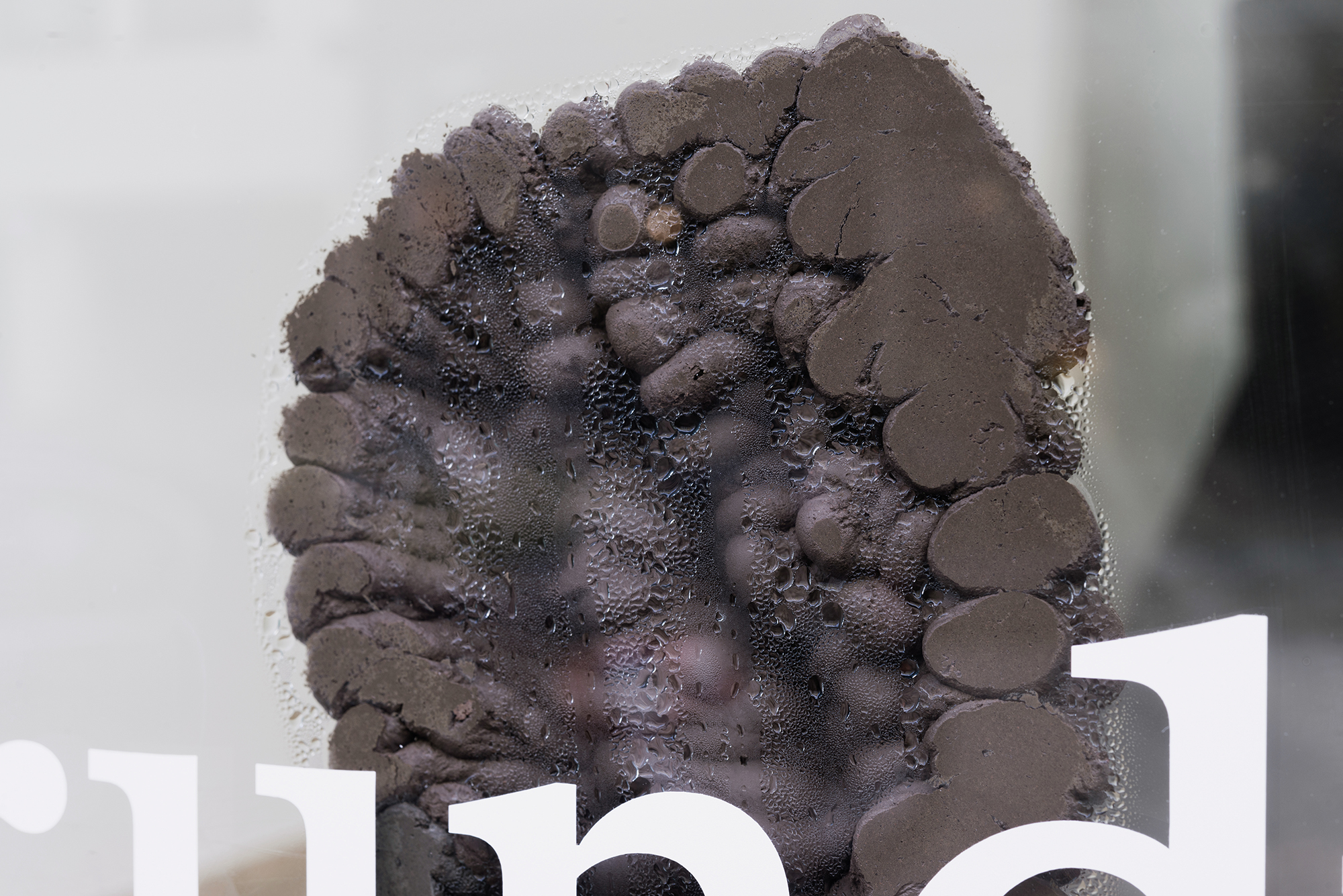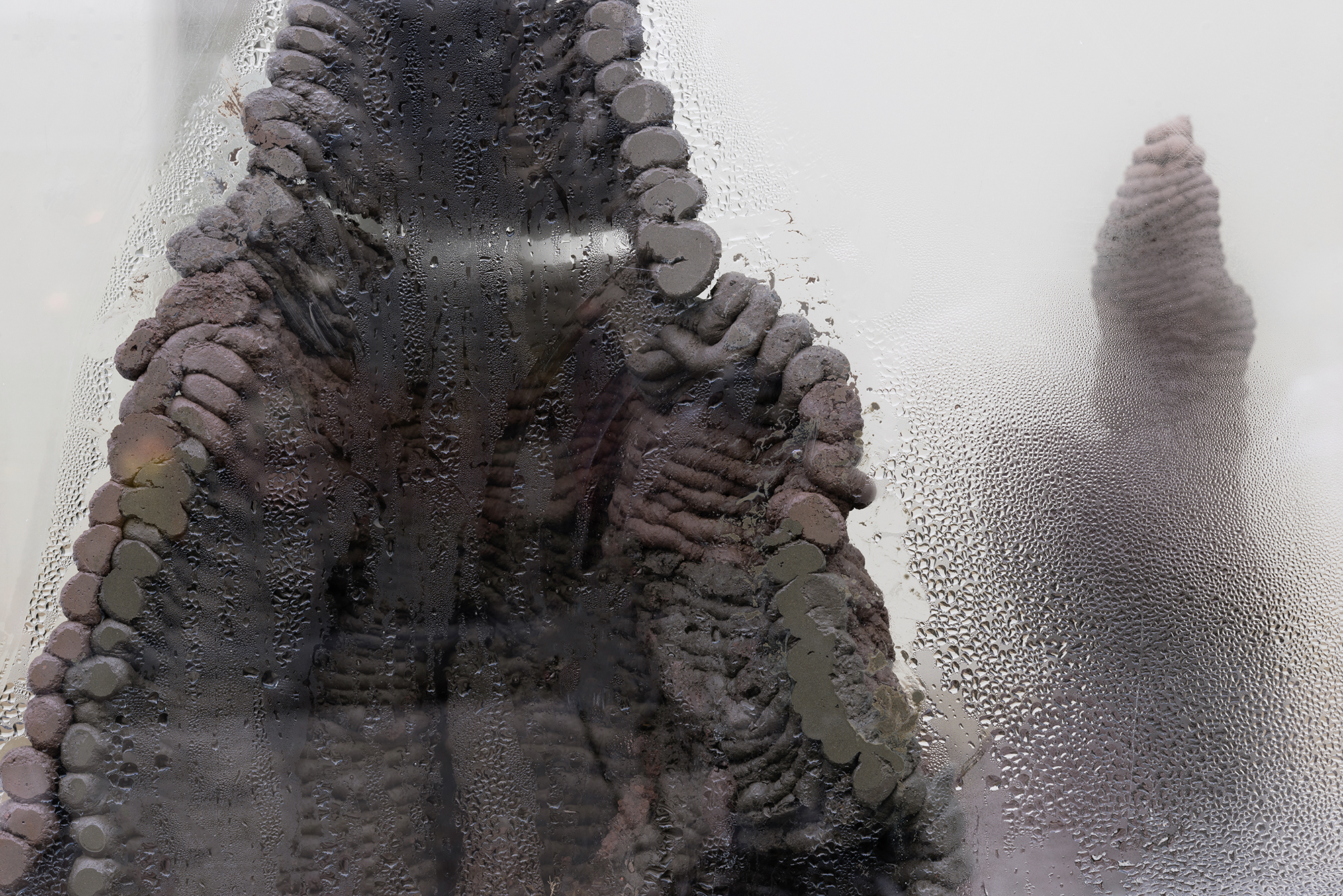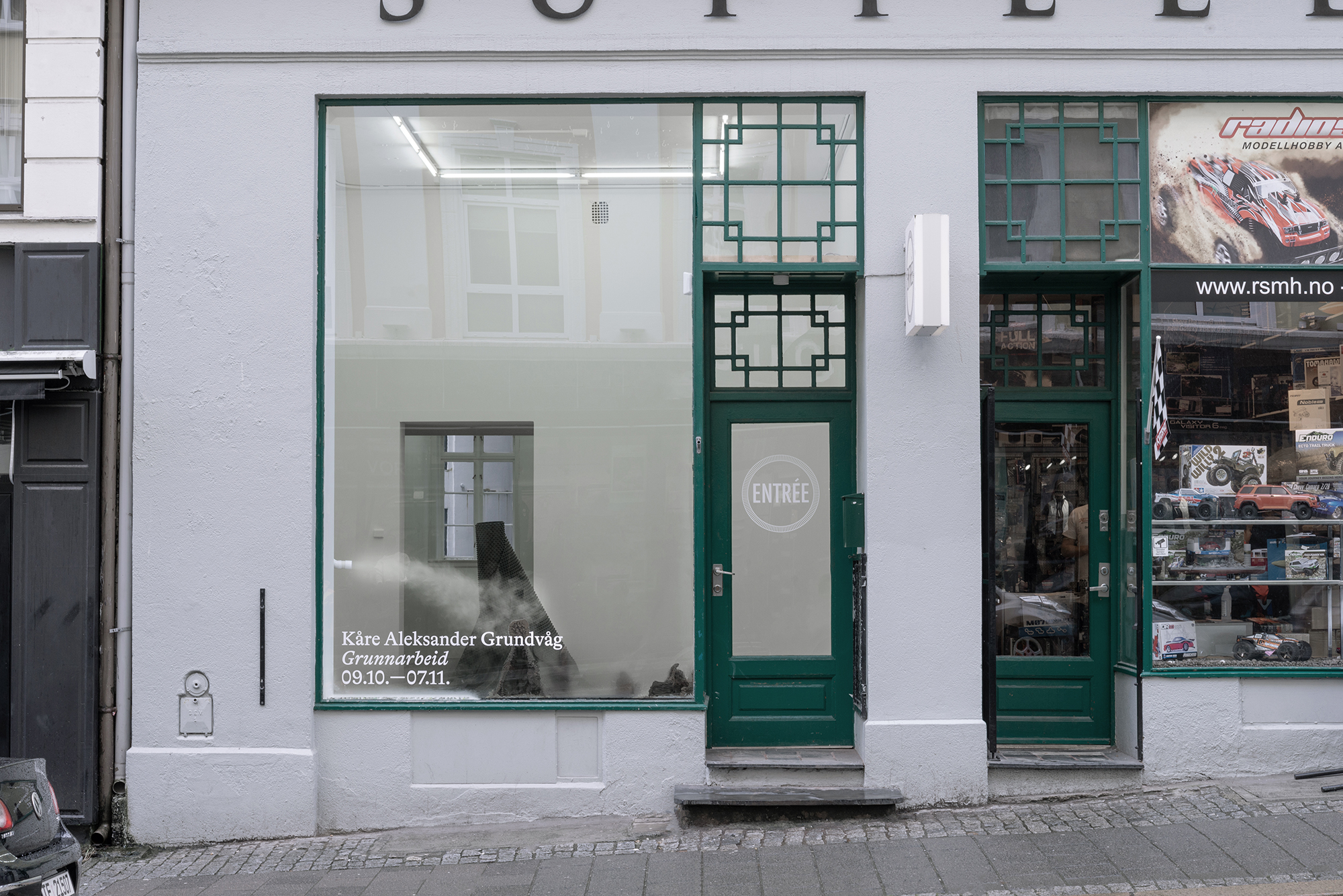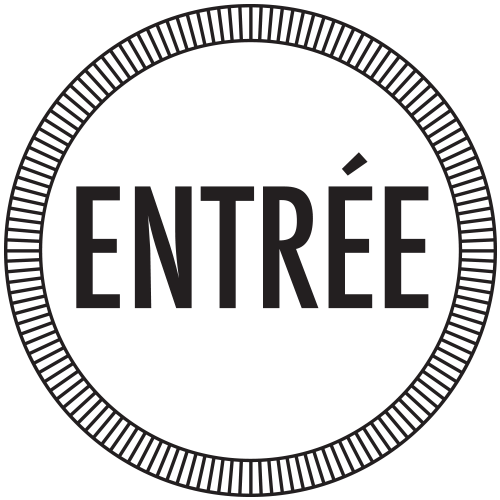October 9th — November 7th, 2021
Kåre Aleksander Grundvåg
Grunnarbeid
Curated by Arne Skaug Olsen
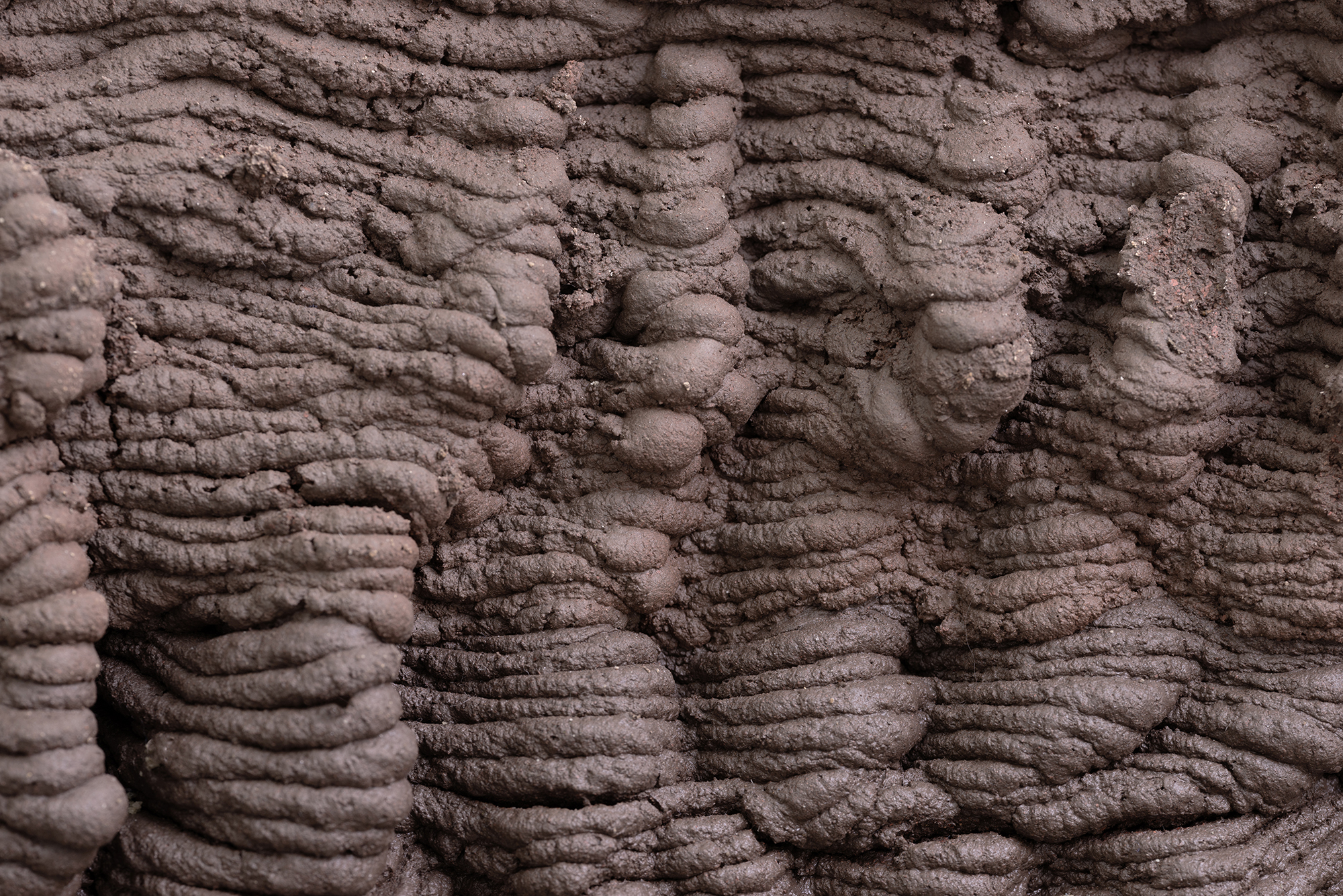
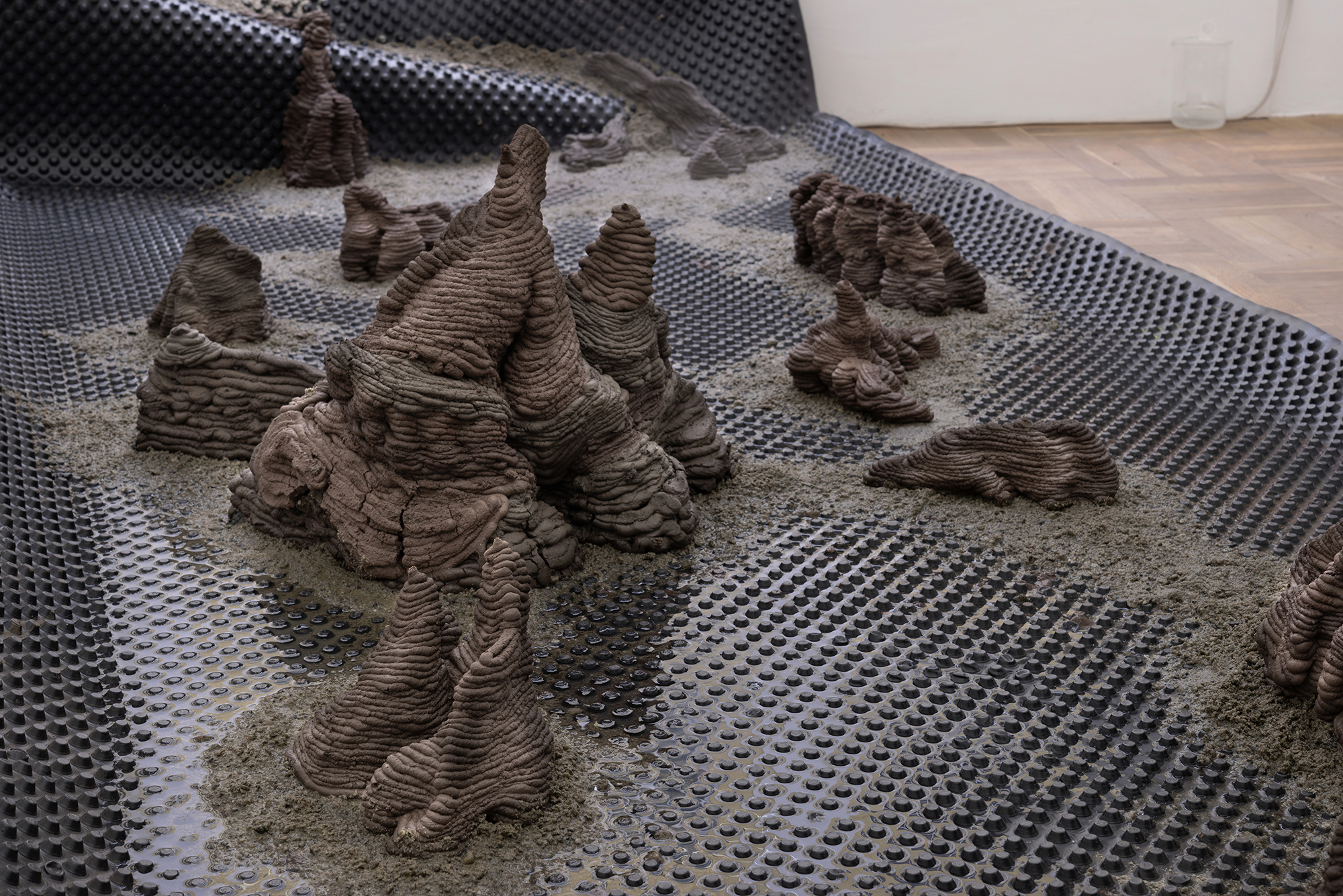
Press:
Kåre Aleksander Grundvåg at Entrée
ArtViewer
01.11.2021
Kåre Aleksander Grundvåg’s exhibition Grunnarbeid (Earthworks) comprises a series of sculptures 3D-printed in earth and clay. The sculptures are unique biotopes allowing local species of vegetation, moss, and algae to grow on them; over the course of the exhibition, the sculptures are in turn transformed through what grows in these biotopes. For the exhibition, Grundvåg has constructed a mechanical human-machine hybrid: combining parts from 3D-printer technology with the human body, he creates sculptural manifestations of how a local biotope and flora change in an antagonistic, yet symbiotic, relationship to human activity. Grunnarbeid is an ongoing project in which soil from multiple places are processed and mixed, and where soil from all previous versions will come together in future iterations.
The title Grunnarbeid alludes to a central aspect of human activity: the redistribution of soil in order to facilitate development of societies and culture – architecture, infrastructure, agriculture, and extraction of natural resources. Common to these activities is their capacity to alter ecosystems – the original interplay between animals, plants, insects, and microorganisms. Some species are displaced, others adapt – and new species are introduced.
The materials Grundvåg uses are collected from landscapes that have been shaped over time by extensive human activity, and where the soil has recently been exposed, by humans or by natural forces. Soil and clay samples are processed and mixed in the gallery, where they form the composite material used in the printing process.
The sculptures at Entrée are made from a mixture of soil and clay from sites in Tromsø and Bergen where historical events and processes have occurred. The soil from Tromsø was collected at Nedre Håpet, where the first edition of Grunnarbeid was displayed in the open in 2020. Nedre Håpet is a small patch of land locked between residential buildings, untouched nature, and industrial facilities. Between 1970 and 2000, the area was populated by a temporary residential housing project for the disadvantaged. Today the houses are gone, their inhabitants spread across the city. Nothing remains but remnants of infrastructure: a stretch of road, a streetlamp and drainage pipes fighting trees and weeds rapidly taking dominion, helped by the original earthworks – planning, draining, the exposure of old layers of soil, planting and fertilising.
In Bergen, Grundvåg has collected soil from three sites. The former royal residence Alrekstad today borders the construction site of the new Bergen Light Rail track, cutting through the historical area. The soil was collected as close to the construction site as possible, in the zone between residential buildings and the excavation site. The other site is on Mount Fløyen – more precisely, collected from the exposed soil underneath the roots of a fallen tree found on a hill with Muledammen to the east and Breistølen to the west. The third soil sample was collected in the rubble after the flood when the Munkebotsvatnet dam broke in 2018.
While the soil in Tromsø and at Alrekstad have been developing since the last ice age, at least, the topsoil of Bergen’s Seven Mountains is young. Prior to 1868, the mountains were almost all bare rock, fell and pasture, a landscape almost devoid of trees. The Bergens Skog- og Træplantningsselskap (Bergen Tree and Forest Planting Society) was founded in 1868 to bring to Bergen continental ideas of a cultivated landscape as a dressed, rather than naked, landscape. The planting of trees was more than a beautification project; the central aspect was the development of a modern cultural identity where wild, uncivilised nature is brought to heel in the image of Man’s superiority over Nature.
Grundvåg’s sculptures present a different picture. In this picture, nature and culture continuously mirror eachother. We exploit and shape nature with cultural, political, and economic goals, while nature adapts, finding new ways to express itself – and whether we like it or not, starts to speak a language we can understand and are unable to ignore.
- Arne Skaug Olsen
Kåre Aleksander Grundvåg (b.1984) is a visual artist based in Tromsø. The coastal landscape of northern Norway is both his frame of reference and home. He holds a BA and Ma degree from the Academy of Fine Arts in Tromsø (2015). He is currently exploring non-human architecture through sculptural interventions in public spaces. Material knowledge, biomimetics and self-reliance are important elements in his work and thinking. Together with visual artist Trond Ansten, he formed the artist duo Devil´s Apron, which investigates the use of seaweed and marine resources through social and ecological experimentation, with a focus on combining traditional knowledge and new research. His work has recently been shown at Format Oslo (2021), Bergen Kunsthall (2021), Kunsthalle Wien (2021), Nordnorsk Kunstmuseum (2021), Kurant Tromsø (2020), The Autumn Exhibition Oslo (2019), LIAF Svolvær (2019), Barents Spectacle Kirkenes (2019), Meat the Future A.K.T Pforzheim (2019), and Arctic Arts Festival Harstad (2018).
Arne Skaug Olsen (b. 1974) is an artist, curator and writer. He holds an MFA in photography and an MA in Curatorial Practice from Bergen National Academy of Arts. Skaug Olsen has worked within higher art education for a number of years, and his last position as Associate Professor at Tromsø Art Academy, and currently at Faculty of Art, Music and Design, The Art Academy, University of Bergen. His ongoing project Fermenting Subjects, a collaboration with artist Anders Dahl Monsen, attempts to give microorganisms a voice and political agency. Fermenting Subjects’ next iteration will be at ALDEA in Bergen, and at Anchorage Art Museum, both in 2022. He also curated the Lofoten International Art Festival in 2015. He has also published art reviews for online journal Kunstkritikk since 2011, and he co-founded the art publishing project Ctrl+Z with Anne Szefer Karlsen in 2004. As an artist, he has participated in Biennale du Benin (2016) and Bergen Assembly (2012) and he was one of the artists at the Arctic Arts Festival, Harstad in 2018.
The exhibition is supported by Bergen Municipality. Entrée is supported by Arts Counsil Norway, and Bergen Municipality.
//Scroll ned for norsk tekst //
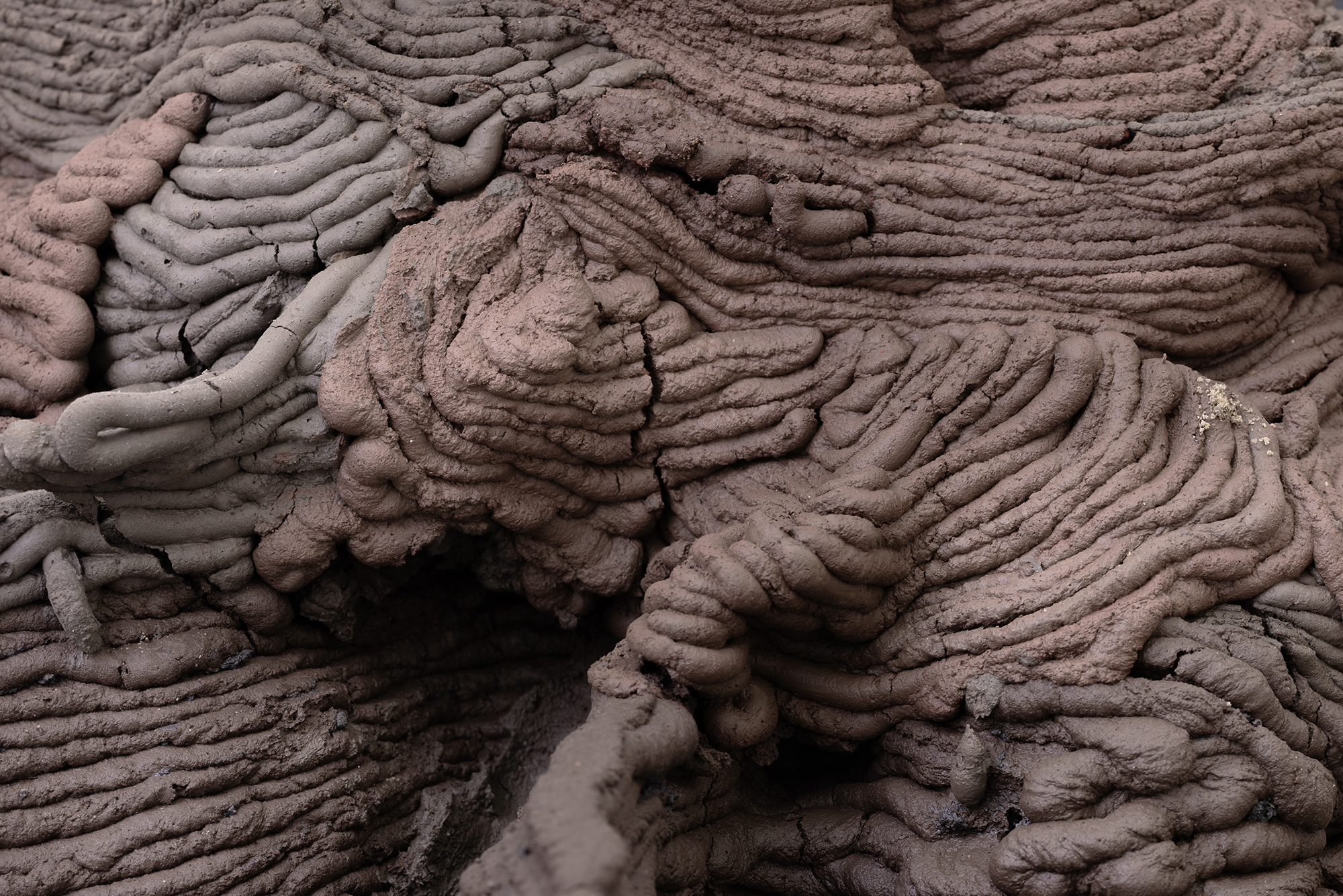
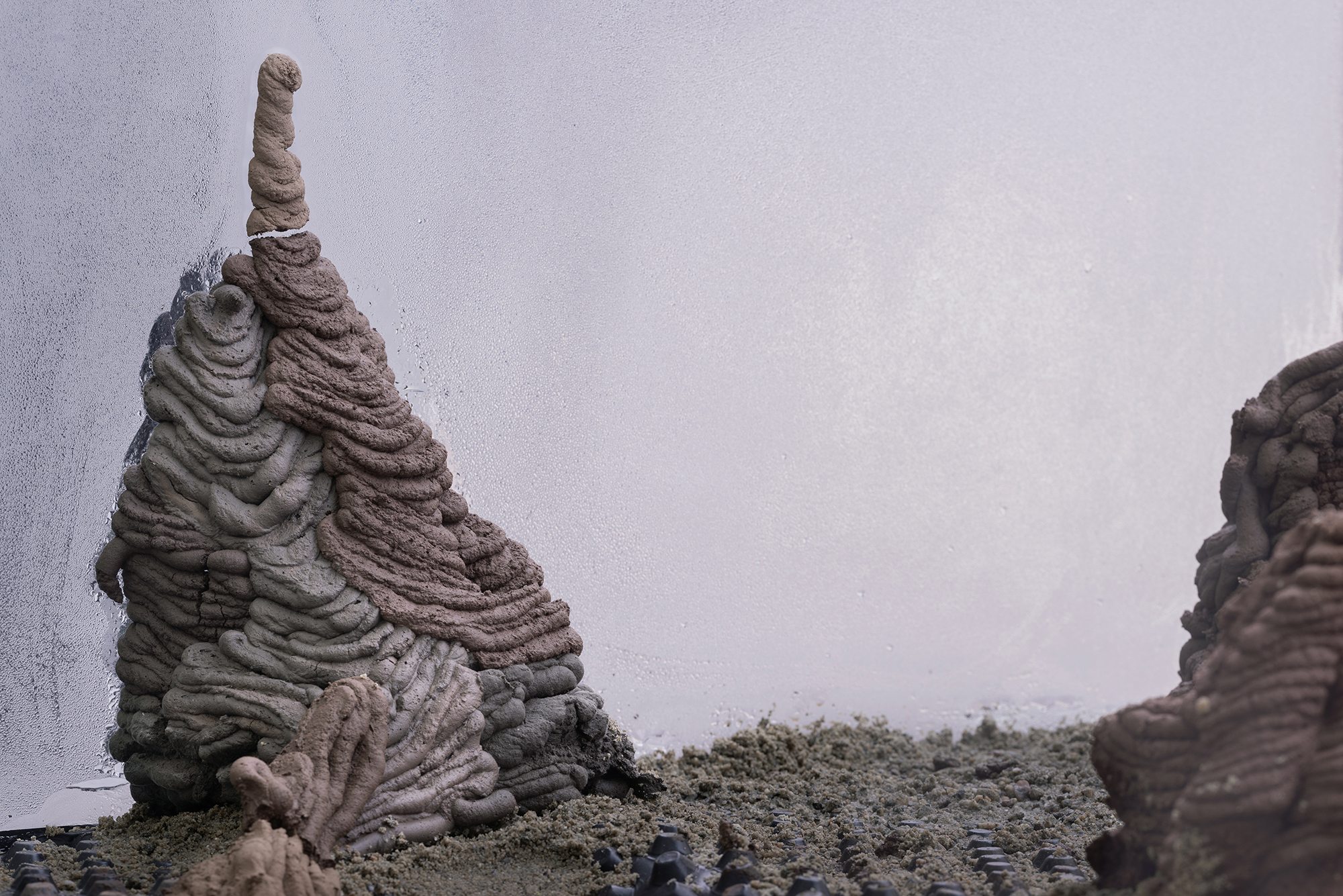
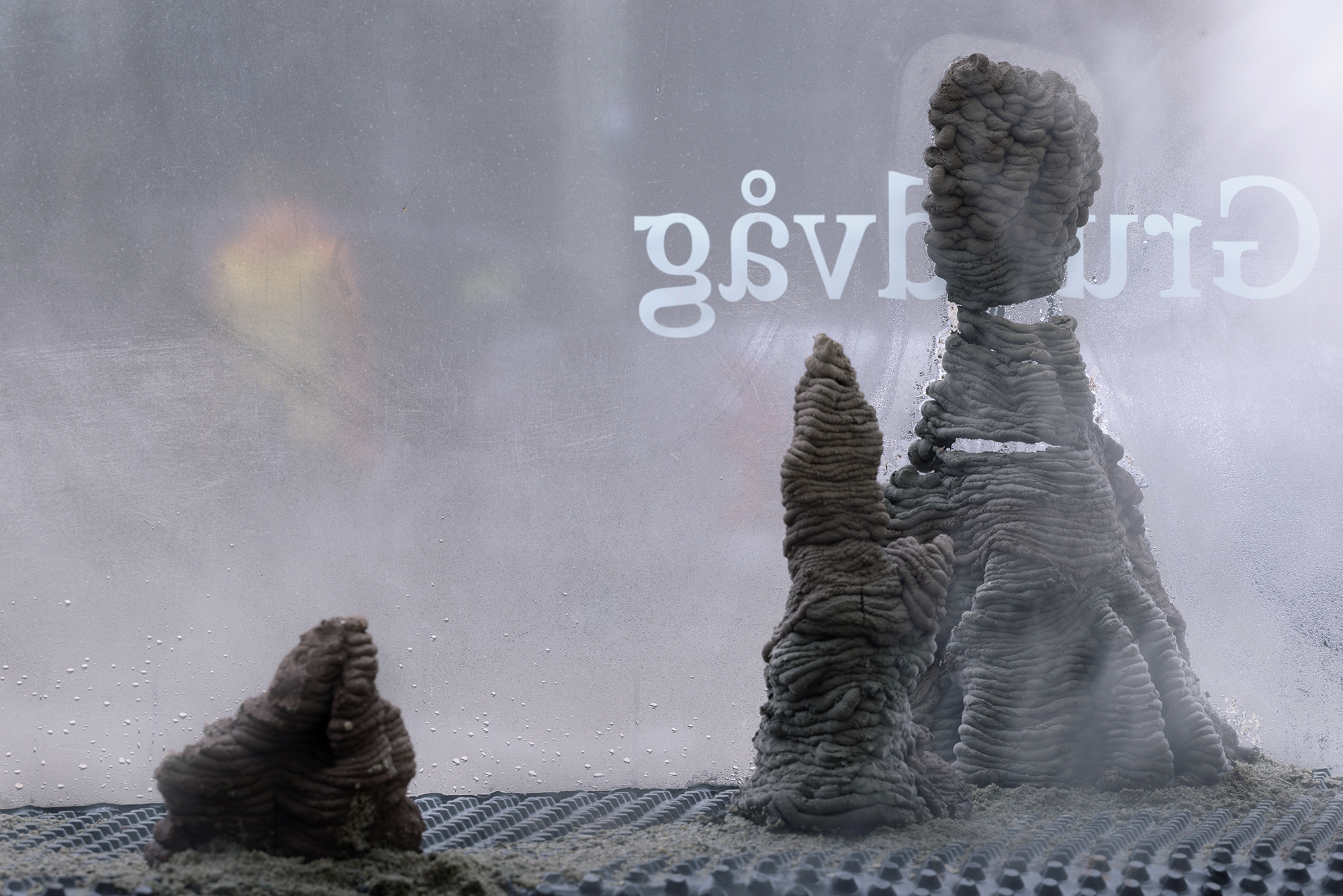

Kåre Aleksander Grundvåg has printed sculptures on-site for the exhibition at Entrée, using earth and clay collected from several sites in Tromsø and Bergen linked to places of human history and activity.
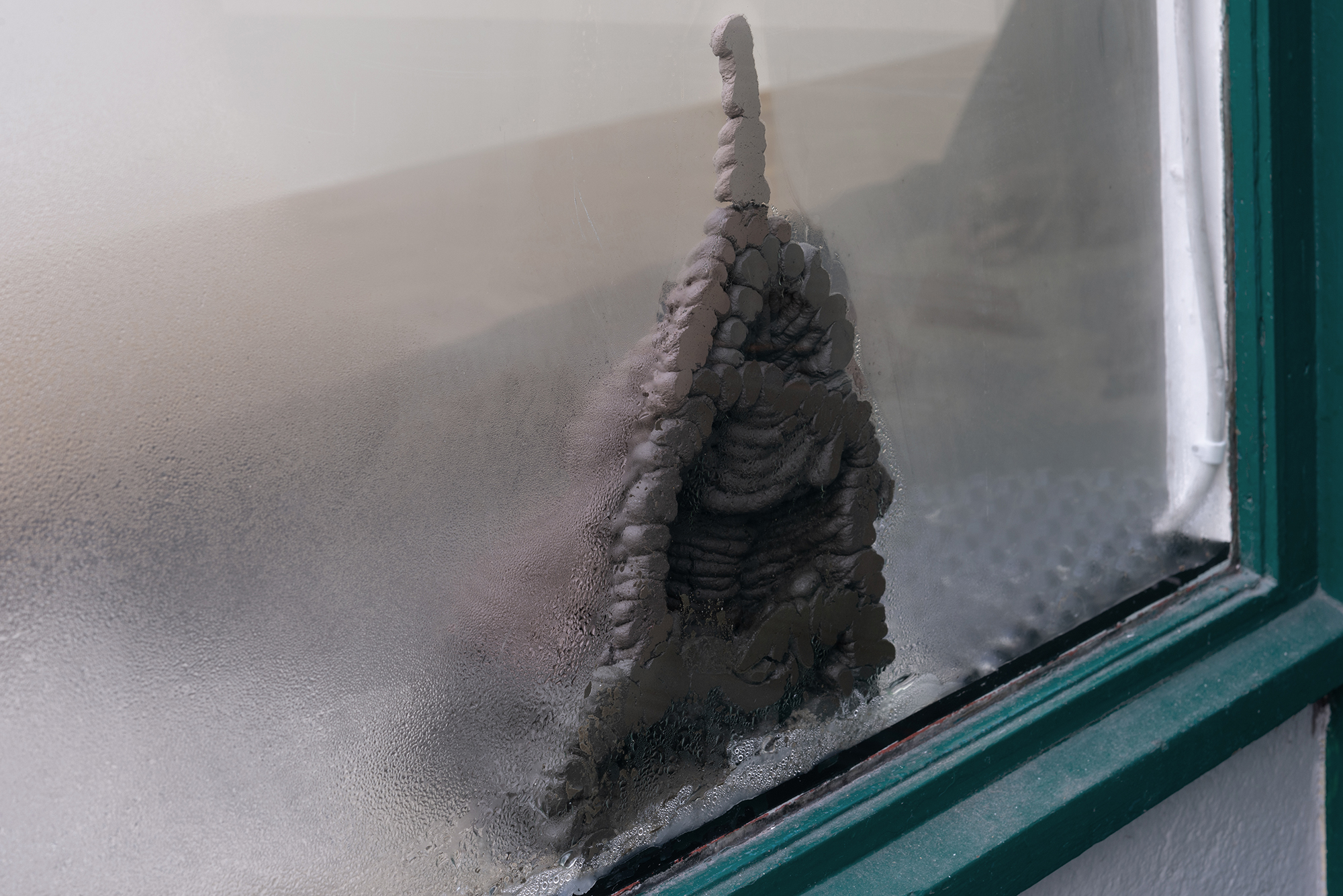
The raw sculptures are being fired in the kiln after the exhibition period and returned to the same locations in nature with a potential of becoming homes for other species or perhaps archaeological curiosities of a distant future.
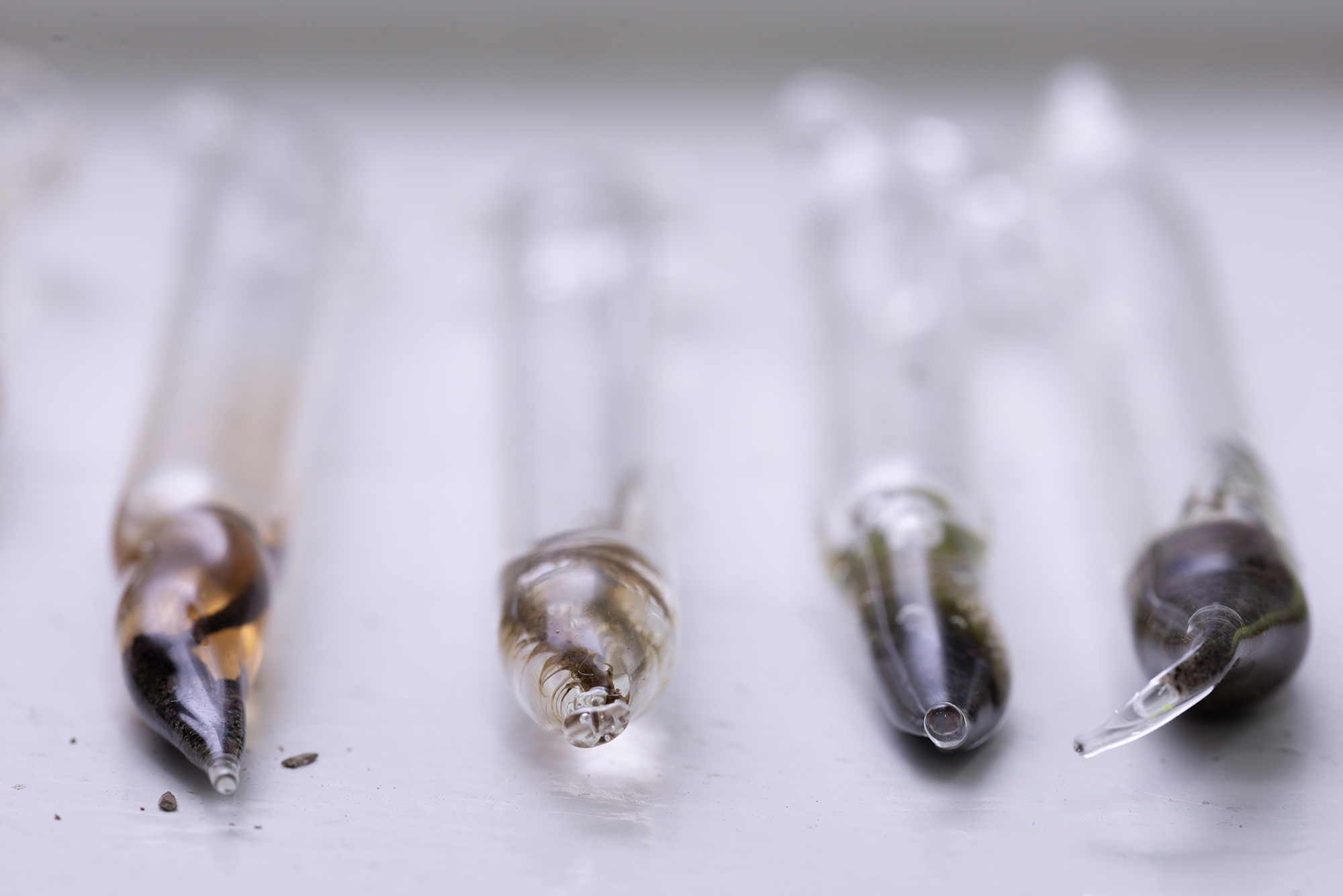
Glass ampoules containing unique and balanced terrarium ecosystems combining material from several locations in Tromsø and Bergen.
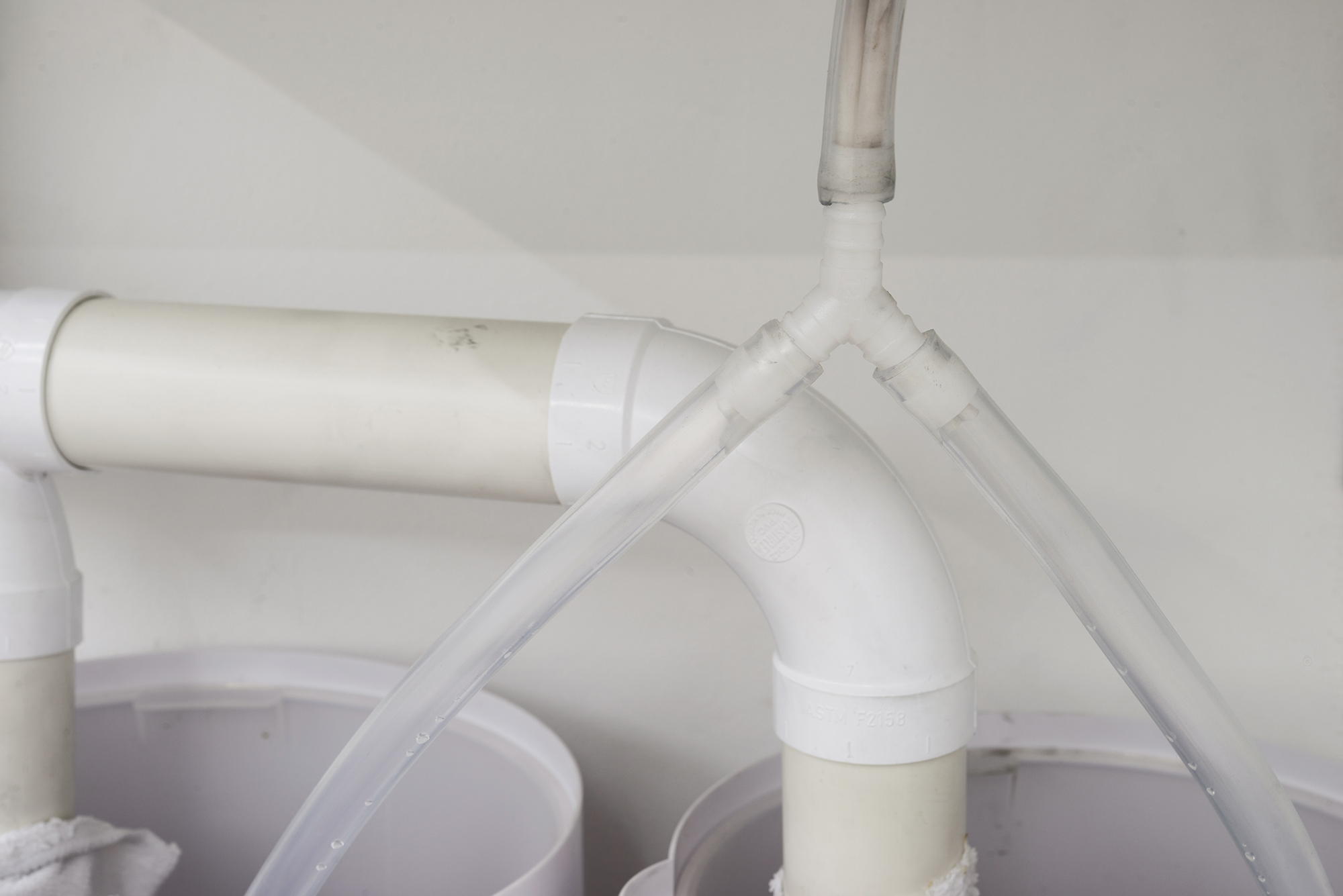 The
gallery is made into an ecosystem providing perfect conditions for the
sculptures' biotopes, allowing local species of vegetation, moss, and algae to
grow on the sculptures through the course of the exhibition.
Steam, alongside moisture from the gallery and its
audiences, gets collected by a dehumidifier and is recycled back as water into
connected humidifiers. The water then loops back as foggy mist.
The
gallery is made into an ecosystem providing perfect conditions for the
sculptures' biotopes, allowing local species of vegetation, moss, and algae to
grow on the sculptures through the course of the exhibition.
Steam, alongside moisture from the gallery and its
audiences, gets collected by a dehumidifier and is recycled back as water into
connected humidifiers. The water then loops back as foggy mist.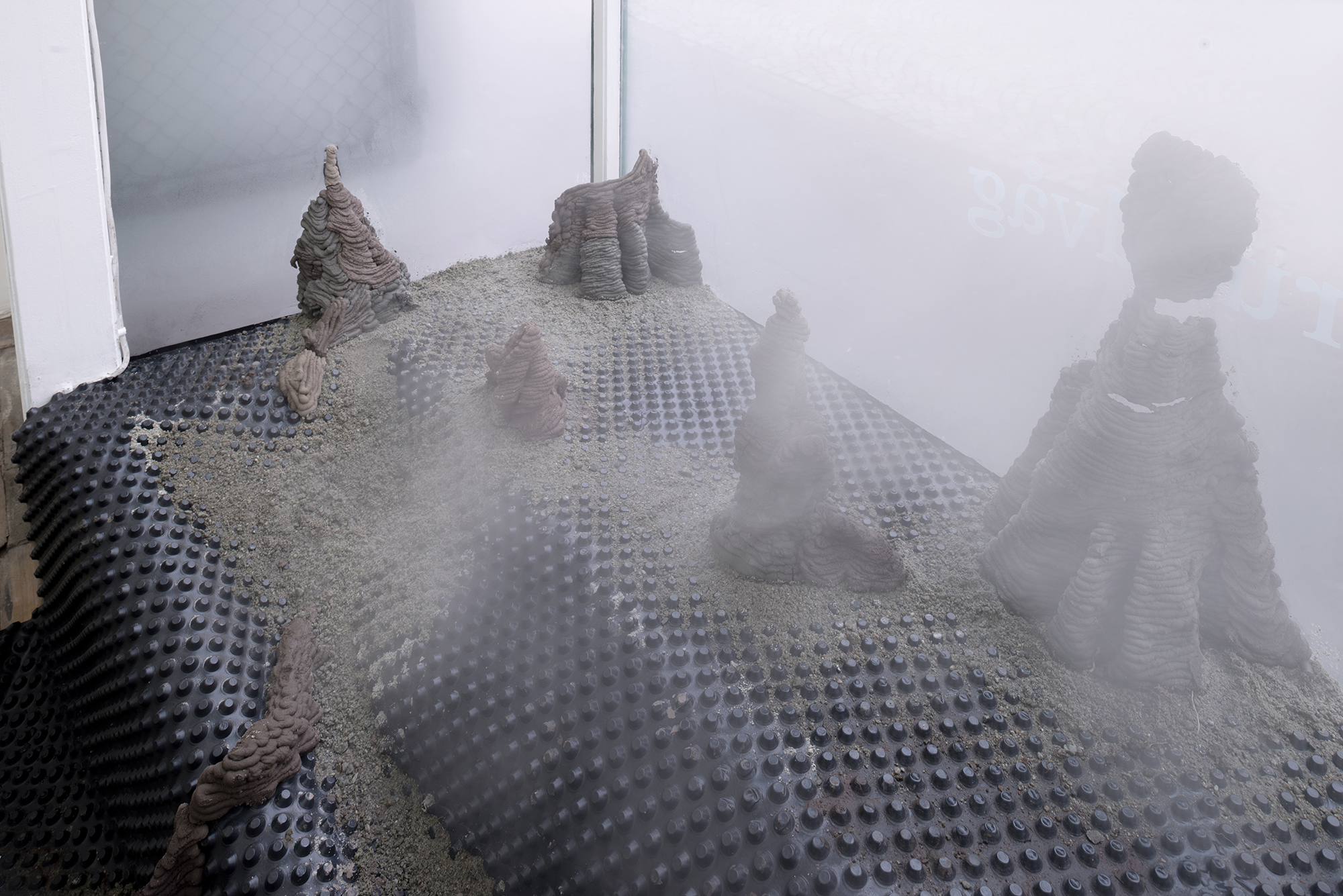
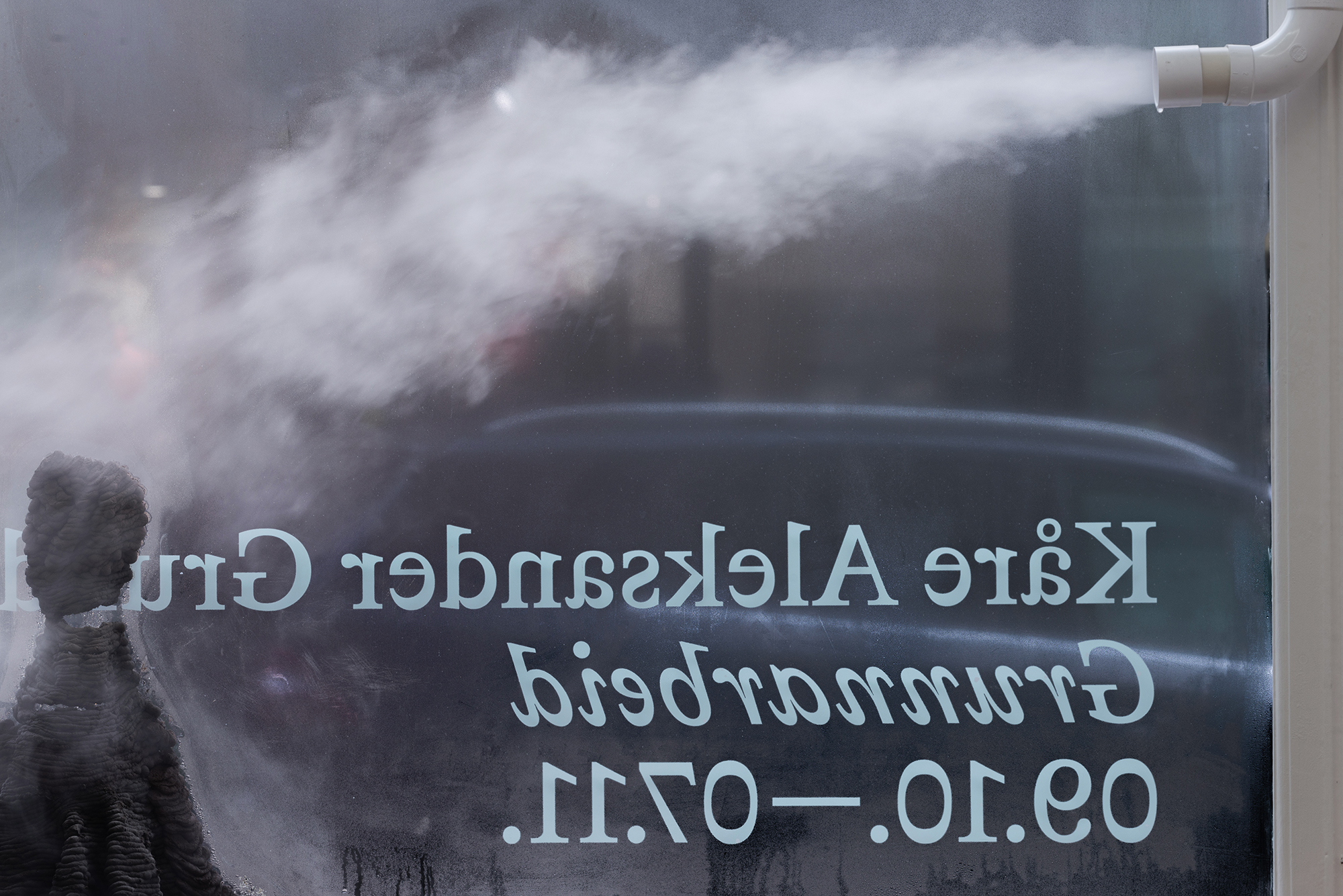 Kåre Aleksander Grundvåg Grunnarbeid. All photos by Bjarte Bjørkum.
Kåre Aleksander Grundvåg Grunnarbeid. All photos by Bjarte Bjørkum.// Norsk //
Kåre Aleksander Grundvågs utstilling Grunnarbeid består av en serie skulpturer 3D-printet i jord og leire. Skulpturene er unike biotoper hvor stedegne planter, sopp, mose og alger kan vokse, og dermed transformeres i løpet av utstillingsperioden. Til utstillingen har Grundvåg konstruert en mekanisk menneske-maskin hybrid som kombinerer kunstnerens kropp og 3D-printerteknologi. På denne måten er skulpturene manifestasjoner av hvordan et steds biotop og flora utvikler seg i et antagonistisk, men samtidig symbiotisk forhold til menneskelig aktivitet. Grunnarbeid er et pågående prosjekt hvor jord fra forskjellige steder bearbeides og blandes, og hvor jord fra alle stedene kommer sammen i fremtidige versjoner av prosjektet.
Tittelen Grunnarbeid viser til et sentralt aspekt ved menneskelige aktivitet: Forflytning av jordmasser for å legge til rette for utvikling av samfunn og kultur – arkitektur, infrastruktur, jordbruk, og utvinning av naturressurser. Felles for disse aktivitetene er at de endrer økosystemer – det opprinnelige samspillet mellom dyr, planter, insekter og mikroorganismer. Noen arter fortrenges, mens andre tilpasser seg – og nye arter introduseres.
Materialene han benytter seg av er hentet fra landskap som er formet etter lang tid med menneskelig aktivitet, hvor jordmasser nylig har blitt avdekket, av mennesker, eller av naturkrefter. Jordprøver og leire prosesseres og blandes i galleriet, hvor de brukes som materiale for printeprosessen.
Skulpturene ved Entrée er laget av en blanding jord og leire fra steder i Tromsø og Bergen, hvor ulike historiske forløp og hendelser har utspilt seg. Jorden fra Tromsø er hentet fra Nedre Håpet, hvor første versjon av Grunnarbeid ble vist utendørs i 2020. Nedre Håpet er et lite landområde klemt inn mellom boligbygging, urørt natur og industri. Mellom 1970 og 2000 var det her en liten klynge midlertidige kommunale boliger. Idag er boligene revet, og beboerne spredt utover Tromsøya. Ingen bygninger står igjen, kun rester av infrastruktur, en veistubb, en gatelykt og avløpsrør. Naturen har derimot tatt stedet raskt tilbake, hjulpet av grunnarbeidet på området: planering, drenering, eksponering av nye jordlag, beplantning og gjødsling.
I Bergen har Grundvåg hentet jordmasser fra tre områder. Det gamle kongsgården Alrekstad på Årstad grenser idag til den massive bybaneutviklingen som skjærer gjennom området. Massene er hentet ut så nærme anleggsområdet som mulig, i sonen mellom bebyggelsen og bybaneutgravingen. Den andre lokaliteten er på Fløyfjellet, nærmere bestemt fra under en rotvelt på et høydedrag mellom Muledammen i øst, og Breistølen i vest. Den tredje jordmassen er hentet fra restene etter flommen da demningen ved Munkebotsvatnet brast i 2018.
Mens jordsmonnet i Tromsø og ved Alrekstad har utviklet seg siden forrige istid, er det øvre jordlaget i byfjellene i Bergen ungt. Før 1868 var byfjellene for det meste ur, berg og beitemark, og et nærmest treløst kulturlandskap. Bergens Skog- og Træplantningsselskap ble stiftet i 1868, og brakte til Bergen kontinentale ideer om det kultiverte landskapet som et bekledd landskap. Treplantingen var mer enn et forskjønningsprosjekt, det sentrale var utviklingen av en moderne kulturell identitet hvor den ville, usiviliserte naturen skulle temmes og bli et bilde på menneskets overlegenhet over naturen.
Grundvågs skulpturer presenterer et annet bilde, et bilde hvor natur og kultur er i en kontinuerlig prosess og speiler hverandre. Vi utnytter og former naturen med kulturelle, politiske og økonomiske mål, mens naturen tilpasser seg og finner nye veier og nye måter å uttrykke seg på, og enten vi liker det eller ikke begynner naturen å snakke et språk vi kan forstå.
- Arne Skaug Olsen
Kåre Aleksander Grundvåg (f. 1984) er en billedkunster bosatt i Tromsø. Kystlandskapet i Nord-Norge er både hans referanseramme og hjem. Han har en mastergrad fra Kunstakademiet i Tromsø (2015). I sitt arbeid utforsker han ikke-menneskelig arkitektur gjennom skulpturelle intervensjoner i offentlig rom. Materialkunnskap, biomimetikk og selvberging er viktige elementer i hans arbeid og tenkning. Sammen med billedkunster Trond Ansten utgjorde Kåre Grundvåg kunstnerduoen Devils Apron, som utforsket bruken av tang og havressurser gjennom sosial og økologiske eksperimenter. Med søkelys på å forene tradisjonell kunnskap og nyere forskning. Hans arbeid har nylig blitt vist hos Format Oslo (2021), Bergen Kunsthall (2021), Kunsthalle Wien (2021), Nordnorsk Kunstmuseum (2021), Kurant Visningsrom, Tromsø (2020), Høstutstillingen Oslo (2019), LIAF Svolvær (2019), Barents Spektakel Kirkenes (2019), Meat the Future A.K.T Pforzeim (2019), Festspillene i Nord-Norge Harstad (2018) og Arctic Art Forum Arkhangelsk (2018).
Arne Skaug Olsen (f. 1974) er kunstner, kurator og skribent. Han er utdannet ved Kunsthøgskolen i Bergen med master i Fotografi og master i Skapende kuratorpraksis. Skaug Olsen har i en årrekke undervist ved Kunsthøgskolene i Bergen og Oslo, sist som førsteamanuensis ved Kunstakademiet i Tromsø. Hans pågående lydprosjekt Fermenting Subjects er et forsøk på å gi mikroorganismer en stemme og politisk agens. Fermenting Subjects et samarbeid med billedkunstner Anders Dahl Monsen og skal i 2022 vises ved ALDEA i Bergen og Anchorage Art museum i Alaska. Han er kunstkritiker og har jevnlig publisert på nettstedet Kunstkritikk. Han kuraterte Lofoten International Art Festival (LIAF) i 2015 og hans siste kuratoriske prosjekt var utstillingen Steinalderdrømmer ved Nordnorsk Kunstnersenter i 2018. I 2004 etablerte han sammen med Anne Szefer Karlsen kunstforlaget CTRL+Z Publishing. Som kunstner har han blant annet deltatt på Biennle du Benin (2012) og Bergen Assembly (2016), og i 2018 var han en av kunstnerne på festspillutstilling under Festspillene i Nord-Norge.
Utstillingen er støttet av Bergen Kommune. Entrée er støttet av Kulturrådet og Bergen Kommune.
